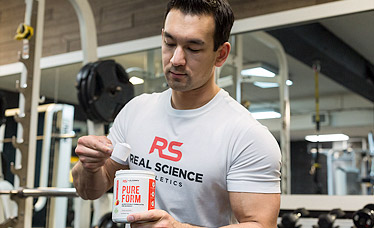NOT GAINING STRENGTH IN THE GYM? (12 SIMPLE FIXES)
Are you struggling to gain strength in the gym?
In this article I outline 12 simple but effective tips to help you speed up your strength gains.
Gaining strength is a fundamental aspect of building muscle.
On the training side of things, it’s the single most important baseline factor to pay attention to.
If your performance in the gym has plateaued and you find that you’re not gaining strength any further, you can pretty much be certain that something in your program is off and that your muscle gains will have plateaued as well.
I’m going to cover each of these twelve points briefly. Treat this article as a checklist.
12 Tips To Increase Lifting Strength
Tip #1: Maintain A Realistic Outlook

Tip number one is to be patient and maintain a realistic outlook on things.
Many people think they’ve hit a strength plateau, when in reality they’re actually still gaining strength at a perfectly reasonable pace.
Remember, gaining strength and muscle mass is a gradual process.
The longer you’ve been training for, the longer it takes to make further strength and muscle gains.
Even performing one extra rep with the same weight on a given lift from week-to-week is still very good progress. Over time, this seemingly small amount of progress will add up.
Don’t expect your strength to go up by leaps and bounds every time you step into the gym.
Gaining muscle is a marathon and is all about the long-term accumulation of very small improvements.
Tip #2: Keep A Training Logbook

Tip number two is to be very detailed and diligent when it comes to tracking your workout performance.
Since increases in strength happen so slowly, they’re often measured in terms of individual reps.
This is why it’s so important that you maintain a written record of each workout session if you want to progress as efficiently as possible. Fail to do this and it becomes very easy to just end up running in circles without even realizing it.
Every time you set foot in the gym you should be writing down which exercises you performed, the amount of weight lifted, number of reps executed and then aiming to gradually build on those numbers over time.
Don’t make the mistake of trying to keep all of this information in your head.
Having objective workout logs will hold you accountable and allow you to progress much more quickly over time.
For every upcoming workout you’ll know exactly what you did last time and what you need to do this time in order to improve.
It’s also very motivating to be able to look back months and years in the past in your tracking log and see just how much progress you’ve made.
Tip #3: Increase Your Calorie Intake

Tip number three to break through a strength plateau is to bump your calories up slightly.
As you’re lifting more weight from month to month and gaining more muscle, your body will require additional calories to both maintain what you’ve built and to make additional progress.
If you find that you’re not gaining strength in the gym, and your body weight on the scale hasn’t changed at all over the past 1-2 weeks, then a small increase of 100-150 calories daily is often all you’ll need in order to get things moving again.
Tip #4: Incorporate Lower Rep Work

Tip number four is to make sure you’re incorporating at least some lower rep work in your routine.
You can build muscle effectively training in almost any rep range as long as you’re applying the principle of progressive overload.
But if you’re primarily concentrating all of your training up in those higher rep ranges (around 10-12+ per set), then mixing in some lower rep work (somewhere in the 5-7 rep range) can be an effective strategy for breaking through a strength plateau.
A lower rep range is effective for stimulating hypertrophy and is also especially effective for speeding up strength gains.
Tip #5: Increase Rest Time Between Sets

Tip number five is to increase your rest time in between sets.
If your goal is to maximize muscle size and strength gains then you shouldn’t be taking any individual set lightly.
You want to be putting forth your very best performance on every single set in order to provide your body with the strongest muscle building and strength gaining stimulus possible.
Rushing into your next set before you’ve fully recovered from the previous one will be counterproductive to the goal of maximizing performance.
Rather than having a set rest interval between sets, a much better approach is to simply perform a given set and then rest as long as you need to in order to feel fully mentally and physically prepared for the next one.
The exact amount of rest you’ll require will vary between exercises depending on how much weight is being lifted and how many muscle groups are involved in the movement. As a general rule though, anywhere from about 2-4 minutes will be appropriate most of the time for optimal performance.
If you need to rest even longer than that after a particularly challenging lift, that’s fine too.
Tip #6: Perform A Proper Warm-Up

Tip number six is to perform a proper pre-workout warm-up.
This will not only help you prevent injuries, but it can also have a direct positive effect on your strength levels as well.
The specific component of the warm-up that will be most important in that regard is weight acclimation sets.
I recommend implementing weight acclimation sets before each major compound exercise during your workout.
In order to do this, start off with a very light weight for higher reps. Then gradually increase to a heavier weight for lower reps until you get up to your maximum working weight.
These sets should only serve as a warm up and should not fatigue you in any way.
Warming up this way will:
- Fire up your central nervous system (CNS)
- Get you accustomed to the movement
- Help you establish a mind-muscle connection
- Increase your strength during your primary working sets
A basic template you can use for warming up is to perform 50% of your working weight for about 8 reps, 75% for 3 reps, and 100% for a single rep.
After these warm-up sets, you can then proceed with your first working set.
Tip #7: Reduce Cardio Volume/Frequency

Tip number seven is to make sure you aren’t going overboard with cardio.
This includes regular gym cardio as well as any other physically demanding exercises or hobbies you’re performing outside of the gym such as sports, classes or strenuous outdoor activities.
Always remember that your time off from the gym is when your body is resting and recovering.
Performing too much additional activity beyond your weight training workouts in the gym can produce more muscle damage and overall fatigue than your body is able to recover from.
As a result, you may hit a strength plateau.
Two to three cardio sessions per week are where I’d cap things if building muscle and gaining strength optimally are a top priority for you.
Also make sure to avoid performing full cardio sessions before weight training, as this will interfere with your lifting performance.
Tip #8: Reduce Weight Training Volume/Frequency

Tip number eight is to reduce your weight training volume and frequency.
If your cardio sessions are under control and you’re not overtraining in that area, another step you can try if you find that you’re not gaining strength from week to week is to reduce your actual weight training volume.
You don’t need to be performing super high volume workouts 6 days a week in order to gain strength and build muscle effectively.
In fact, if you go too far overboard, you can easily push your body beyond its ability to recover optimally (especially if your nutrition and sleep aren’t on point).
If your strength gains have come to a halt and you can’t seem to improve, try lessening the overall weight training workload to see if this helps.
That could mean going from 5 workouts per week down to 4, 4 down to 3, or reducing the total number of sets performed for each session.
As a general rule of thumb, approximately 8-15 total sets per week for larger muscle groups and 4-8 sets for small muscle groups is usually enough volume when training at an intensity level of about 1-2 reps short of failure on your sets.
Tip #9: Implement A One-Week Deload

Tip number nine is to do a 1 week deload.
This would mean either:
- Continuing to train but reducing the weight on all of your lifts by 50%
- Taking an entire week off altogether
I’d recommend implementing a 1 week deload every 6-12 weeks of consistent heavy lifting.
Deloading is a great way to give your CNS, joints, and muscles a chance to fully recover from all the previous weeks of intense training.
Deloading can help to prevent sticking points and actually allow you to gain more strength over the long term.
Tip #10: Optimize Your Sleep Quality

Tip number 10 is to ensure you’re sleeping well each night.
Sleep is very important for optimizing your performance in the gym.
Short term sleep deprivation might not be a huge issue, but if you’re sleep deprived over the long term, then you can be sure this will negatively affect your strength progress and resulting muscle gains.
The optimal amount of sleep is going to vary from person to person depending on a wide variety of factors. Just make sure you’re getting an amount of sleep each night that leaves you feeling sufficiently rested.
In general, 7-9 hours per night is appropriate for most people.
Keep in mind that sleep quality is just as important as sleep duration. You can take active steps to improve your sleep quality by:
- Reducing exposure to blue light late at night.
- Reducing caffeine intake in the later afternoon/evening hours.
- Getting sun exposure on a daily basis.
- Sleeping in a cool room.
- Going to sleep and waking up at the same time regularly.
Tip #11: Rotate Your Exercises

Tip number eleven is to try rotating your exercises.
If you’ve followed all of the previous tips and your strength has still plateaued on a certain lift, one thing you can do is to focus on a different exercise for a period of time to mix things up.
For example, you could replace a pull-up with a pull-down, or a barbell press with a dumbbell press, or a dumbbell curl with a cable curl.
Simply use a similar movement pattern, but use a different training tool or angle.
Then work on progressing at that movement for as long as you can before coming back to the previous lift or switching to a different movement variation again.
Tip #12: Utilize A High-Quality Pre-Workout Supplement

Tip number 12 is to utilize pre-workout supplementation to optimize your strength gains.
This isn’t something you should be relying on for strength increases alone, but in addition to all of the previous tips, using a well-formulated pre-workout can help to give you an extra edge to push through strength barriers and spark new muscle growth.
It’s important to choose carefully though, as the majority of pre-workout blends on the market these days are not well-formulated and are mainly based around marketing hype and B.S rather than real supplement science.
If you’re looking for a clean, properly dosed pre-workout formula that truly gets the job done, I’d recommend checking out PureForm from RealScience Athletics.
This is a pre-workout blend I personally formulated and is based off of 4 key ingredients (caffeine, theanine, tyrosine and citrulline malate) in their full clinical doses and highest quality forms.
No proprietary blends or unnecessary fillers and 100% naturally sweetened/flavored.
Summary
Here are the 12 tips covered in this article to help you maintain consistent strength progression.
- Maintain a realistic outlook.
- Keep a training logbook.
- Increase your calorie intake.
- Incorporate lower rep work.
- Increase rest times between sets.
- Perform a proper warm-up.
- Reduce cardio volume/frequency.
- Reduce weight training volume/frequency.
- Implement a 1 week deload.
- Optimize your sleep.
- Rotate your exercises.
- Use a high-quality pre-workout supplement.
Following this advice should solve the majority of strength plateaus out there.
If you found this article helpful, make sure to sign up for your FREE custom fitness plan below...





